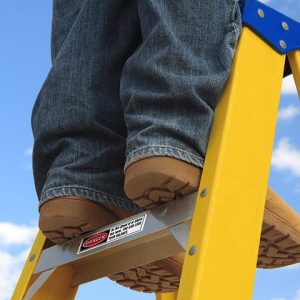Ladders are a necessary tool in many industries, such as construction, roofing, and window cleaning. But, as with any tool, ladders can be dangerous if not used properly. That’s why it’s important to understand ladder safety and the risks associated with ladder use. This article will cover the basics of ladder safety, including types of ladders, safety considerations, tips for safe use, understanding risks, ladder safety regulations, safety equipment and devices, ladder safety training, ladder maintenance, and OSHA ladder safety guidelines.
Introduction to Ladder Safety
Ladders are a necessary tool in many industries and are used for a variety of tasks from painting to window cleaning and home repair. While ladders are an important tool, they can be dangerous if not used properly. In order to ensure safe use of ladders, it’s important to understand the basics of ladder safety. This article will cover the essential information about ladder safety, from types of ladders and safety considerations to tips for safe use and ladder safety regulations.
Types of Ladders and Safety Considerations
There are several types of ladders available, each with their own safety considerations. The most common types of ladders are step ladders, extension ladders, and A-frame ladders. Step ladders are used for short-term tasks, while extension ladders are used for tasks that require a higher reach. A-frame ladders are a variation of the step ladder, with a design that allows them to be used in tight spaces.
When selecting a ladder, it’s important to choose one that is the right height and weight capacity for the job. Additionally, all ladders should be inspected before use to ensure that they are free of any defects or damage. It’s also important to consider the surface that the ladder will be placed on; for example, it’s best to avoid using a ladder on a slippery surface.
Tips for Safe Ladder Use
Once you’ve selected a ladder and inspected it, there are some basic tips to keep in mind to ensure safe use. First, make sure to select the right ladder for the job. An extension ladder is best for tasks that require a higher reach, while a step ladder is more suitable for short-term tasks. Additionally, it’s important to make sure that the ladder is placed on a stable and level surface.
When using a ladder, always maintain three points of contact; for example, two feet and one hand or two hands and one foot. Never lean too far away from the ladder, as this can cause the ladder to become unbalanced and cause an accident. When climbing a ladder, always face the ladder and use the side rails for support. Additionally, it’s important to use a spotter when using a ladder, as this can help to reduce the risk of an accident.
Understanding the Risks of Ladder Use
It’s important to understand the risks associated with ladder use. Falls from ladders are one of the leading causes of workplace injuries. In addition to falls, ladders can cause other types of injuries such as lacerations, broken bones, and electrical shocks. Additionally, ladders can cause property damage, such as damage to a roof or wall.
When using a ladder, it’s important to understand the risks and take the necessary precautions to prevent injuries and property damage. This includes following safety guidelines and using the right ladder for the job. Additionally, it’s important to use a spotter when using a ladder and to inspect the ladder before use.
Ladder Safety Regulations
In the United States, the Occupational Safety and Health Administration (OSHA) has established regulations for ladder safety. These regulations include requirements for ladder selection, inspection, maintenance, and use. Additionally, OSHA requires employers to provide ladder safety training for employees who use ladders in the workplace.
OSHA regulations also require employers to provide safety equipment for ladder use. This includes harnesses, safety nets, and ladder stabilizers. All of these items must be inspected prior to use and maintained according to the manufacturer’s specifications. Additionally, ladders must be stored in an area that is free from hazards, such as wet floors or uneven surfaces.
Ladder Safety Equipment and Devices
There are a number of ladder safety equipment and devices available. Harnesses are one of the most common safety devices and are designed to help prevent falls from ladders. Safety nets can also be used to help cushion a fall and reduce the risk of serious injury. Additionally, ladder stabilizers can be used to help keep ladders in place and reduce the risk of tipping.
Other ladder safety equipment includes hooks, rope, and lanyards. Hooks can be used to secure the ladder to a stable surface to prevent slipping. Rope and lanyards can be used to attach the ladder to a person or object to provide additional support. It’s important to make sure that all of this safety equipment is inspected prior to use and maintained according to the manufacturer’s instructions.
Ladder Safety Training
In addition to providing safety equipment, employers are also required to provide ladder safety training for employees. This training should include information about ladder selection, inspection, and use. Additionally, employers should provide instruction on the use of any safety equipment, such as harnesses and stabilizers.
When providing ladder safety training, employers should also emphasize the importance of following safety guidelines and provide information about the risks associated with ladder use. Additionally, employers should ensure that employees understand the OSHA regulations for ladder safety and provide information about ladder storage and maintenance.
Ladder Maintenance for Safe Use
In addition to providing safety equipment and training, employers should also ensure that ladders are properly maintained. This includes inspecting ladders before each use and replacing any defective or damaged parts. Additionally, ladders should be stored in a dry, well-ventilated area away from any hazards.
For wooden ladders, it’s important to make sure that the wood is not cracked or warped. Additionally, all metal components should be rust-free and all moving parts should be lubricated. Additionally, all ropes and lanyards should be inspected for wear and tear and replaced as needed.
OSHA Ladder Safety Guidelines
The Occupational Safety and Health Administration (OSHA) has established guidelines for ladder safety. These guidelines include requirements for ladder selection, inspection, maintenance, and use. Additionally, OSHA requires employers to provide ladder safety training for employees and to provide safety equipment for ladder use.
OSHA regulations also require employers to inspect ladders before each use and to replace any defective or damaged parts. Additionally, ladders should be stored in a dry, well-ventilated area away from any hazards. Finally, employers should ensure that employees understand the OSHA regulations for ladder safety and provide information about ladder maintenance.
Conclusion
Ladders are an essential tool in many industries, but it’s important to understand the basics of ladder safety. This article has covered key information about ladder safety, from types of ladders and safety considerations to tips for safe use and ladder safety regulations. Additionally, this article has discussed the risks associated with ladder use, ladder safety equipment and devices, ladder safety training, ladder maintenance, and OSHA ladder safety guidelines.
By following the safety guidelines outlined in this article, you can help ensure that ladders are used safely and that the risk of injury or property damage is minimized. For tasks that require a higher reach, leave the ladder climbing to Home Details for all of your gutter cleaning needs.
By understanding the basics of ladder safety and following the safety guidelines outlined in this article, you can help ensure that ladders are used safely and that the risk of injury or property damage is minimized. With the right safety equipment, training, and maintenance, you can make sure that ladders are used safely and that everyone stays safe.

